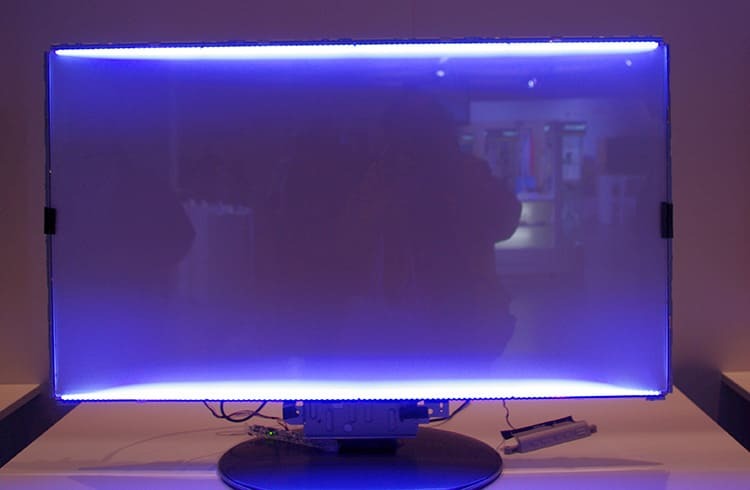
CONTENT
- 1 Features of backlighting in modern LCD-screens
- 2 Edge LED backlight technology - compact and stylish
- 3 Direct LED backlight technology - always shine, shine everywhere
- 4 Which is better - Direct LED or Edge LED
- 5 Drawing conclusions
Features of backlighting in modern LCD-screens
Initially, fluorescent lamps were used as a backlight for LCD screens of monitors and televisions. Yes, you are not mistaken: these were the same "fluorescent lamps" previously widely used to illuminate industrial and public buildings. Only in this case, their size was much smaller. In the world of electronics, this development was called CCFL.

But let's be honest, this technology has become obsolete a couple of decades ago. It has long been replaced by high-performance LEDs. They received the famous name LED (short for Light-Emitting Diode). In addition to environmental safety for humans and the environment, they are also distinguished by low energy consumption and relatively inexpensive manufacturing costs.

The use of such an invention could not but give rise to the subsequent creation of several subspecies of lighting. Perhaps even now there are some innovative developments, but in 2019 the user's choice is conditionally divided between two common solutions:
- Edge LED.
- Direct LED.
It is about the features of these competing "sisters" that we will tell our readers in the framework of further research.

Edge LED backlight technology - compact and stylish
The first option in our case will be an unusual and, to a certain extent, experimental Edge LED-backlighting. Despite the fact that it has a number of significant drawbacks, its use in modern screens is often justified.
Edge LED design features
In order to fully understand what Edge LED backlighting is, we first of all need to translate the first word from the name into Russian. For those who do not want to look into the English-Russian dictionary, let us suggest that the term "Edge" means "Angle". Hence follows the main distinguishing feature of the technology: such a backlight is located on the side edges (most often, the right and left edges) of the inner surface of the display.

Ultimately, this leads to a decrease in the thickness of the monitor or TV, as well as less strain on the eyes. But there is also a very large "fly in the ointment" - with an incorrect distribution of the number of lamps on the sides of the screen and the power of their luminescence, local darkening will be noticeable in the picture or, conversely, too bright fragments.

Advantages and disadvantages
Like any scientific invention, the heroines of our review have strengths and weaknesses. We have partially described the advantages and disadvantages of Edge LED in the previous paragraph, but for now let's put all the pros and cons together for a more complete picture.
| "Pros" | "Minuses" |
| More compact dimensions of the matrix and the body of the LCD device due to the favorable arrangement of the elements. | Increased power consumption due to the need to illuminate a large area with a small number of LED lamps. |
| High brightness and convenience for viewing information. | High risk of localized blackouts due to incorrect manufacturers' calculations. |

Direct LED backlight technology - always shine, shine everywhere
The only and very successful competitor of the first nominee is Direct LED - a more expensive and effective option with a lot of interesting parameters. Let us immediately begin to study its characteristics.
Direct LED design features
Answering the question “What is Direct LED?”, We turn again to the English-Russian dictionary, where it says that “Direct” means “Direct”. This is the idea of the creators. Unlike Edge, equipment using this technology has LED bulbs. are located not on the side faces, but on the back wall, over the entire area, but in compliance a certain interval.

As a result, you will get a high-contrast picture, the characteristics of which can be easily changed without harming the image quality. Also, you don't have to worry about various local dimming of the matrix - they will appear only in case of large-scale breakdowns, which happens extremely rarely.

Advantages and disadvantages
As in the first case, this heroine of our review has a number of strengths and shortcomings. Let's try to bring them together to form a complete opinion.
| "Pros" | "Minuses" |
| High contrast and sharpness of the image. | The dimensions of the device will be significantly thicker in comparison with the Edge-models. |
| The absence of any lighting deficiencies in a particular area of the display due to the rational arrangement of elements. | Even higher power consumption due to the large volume of diodes. |

Which is better - Direct LED or Edge LED
We have figured out the characteristics of each of the options available today. “But this is only theoretical information,” the reader will say, and he will be right. Do not forget the practical application of existing knowledge. It is for this reason that the next point of our review will be the identification of the most worthy winner in the "Edge LED vs Direct LED" duel!

Best solution in terms of image quality
Each of us wants to enjoy bright, rich colors while watching a dynamic blockbuster, intense play in the next computer or console video game. But what type of backlight should you choose for the perfect result? Let's consider each of them separately.
Edge LED. On the side of this nominee there is an increased brightness, combined with a rational direction of light, which reduces eye strain. But at the same time, the image can be more "blurred" due to lower contrast. Therefore, such an offer is suitable for those who work a lot behind the screen or are afraid for their eyesight.

Direct LED. In this case, we have higher sharpness and contrast, which, coupled with adjusting brightness and saturation, can give a much more powerful and consistent result. Such devices are the best choice for demanding viewers and avid gamers.

Optimal parameter in terms of reliability and design
In addition to the quality of the image itself, do not forget about the durability and pleasant appearance of the equipment. After all, what is the use of the equipment if it breaks down after a month of active use? Let's consider the heroines of our review from this side of the issue.
Edge LED. As we said earlier, models equipped with such backlighting have a much more compact size, which has a positive effect on the design. But the small thickness is also an indicator of high fragility, which should not be disregarded either. At the same time, this technology does not perform well on inclined surfaces, since over time the light diffuser can get serious physical deformations.

The Direct LED backlight, in contrast to its rival, on the contrary, thickens the screen dimensions. In some situations, this can also be negative, since massive objects are destroyed much more when they fall. But with proper consolidation and control, this solution is more beneficial in all respects. In addition, this technology is adapted to be positioned on any surface, which is convenient for every user.

Drawing conclusions
So our little research has come to an end. The editors, summing up all the research, summarize - in the duel between Edge LED or Direct LED, our scales still leaned towards the second option. But remember that we are not the ultimate truth. When choosing products, also listen to your personal feeling. We wish you happy shopping and decisions!



